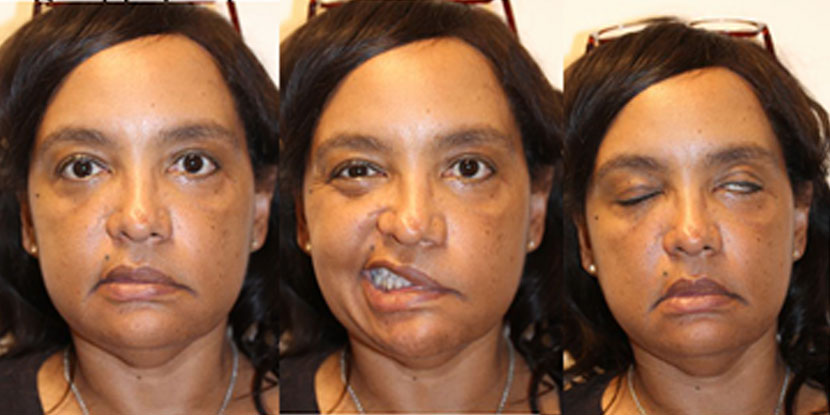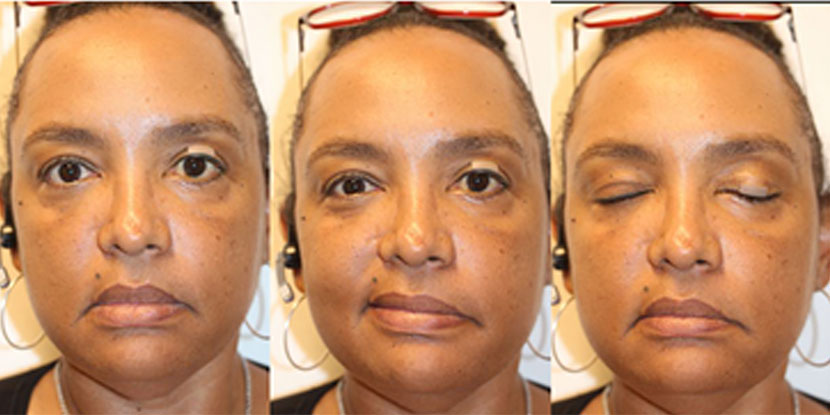Editor’s note: The Academy’s YO Info Editorial Board is collaborating with YO leaders from our partner subspecialty societies to highlight YO authors contributing clinical pearls. This is the first in a series of articles, Clinical Pearls for YOs to Know, with a YO author suggested by YASOPRS, the YO Committee of the American Society of Ophthalmic Plastic and Reconstructive Surgery (ASOPRS).
After reading this, you will know how to manage patients with a facial nerve palsy, a common problem general ophthalmologists will encounter. Early intervention for corneal protection will help protect the patient’s visual recovery in the long term. Although some patients only need lubrication with artificial tears, many would benefit from or require more aggressive intervention.
Here’s how one patient with a sudden case was treated successfully and lessons you can learn.
Six weeks after an episode of left mastoiditis, she developed leftsided lagophthalmos, orbicularis oculi weakness, facial weakness and corneal inferior punctate keratopathy, consistent with a left-sided facial nerve palsy. She had been suffering from significant dry eye and her ophthalmologist placed her on hourly lubricating gel eyedrops and ointment at night. Her vision was 20/20 OD and 20/25 OS.

A 51-year-old female with left facial weakness following left mastoiditis six weeks prior. Photo courtesy of USC Roski Eye Institute
What to Do When Encountering a Patient With CN7 Palsy
- Look at the forehead. If the forehead is spared, obtain head/brain imaging for central nervous system causes. A supranuclear cause will cause a palsy of the lower face; a peripheral cause will affect the entire side of the face. Look for hemifacial spasm. If present, order an MRI with special focus on the internal auditory canal to more finely evaluate the path of the seventh nerve, including near the skull base for presence of a tumor or vascular compression/irritation of the nerve.
- Check for concomitant Cranial Nerve V trigeminal denervation. Check for decreased corneal sensation to see if you will need to be extra watchful with a neurotrophic cornea. Imaging is also more warranted when there are multiple cranial nerves involved. Focusing on…
- Lubricate, lubricate, lubricate. Aggressive lubrication is required, but often lubrication with topical tears and ointment at night may not be sufficient.
- Moisture chamber highly recommended. Online retailers such as Amazon sell moisture chambers which can be particularly protective at night for persistent lagophthalmos. If patients have trouble keeping it on, or need to wear one all the time due to severe orbicularis oculi weakness, they can consider Eye Seals by Eye Eco (recommended to me by a patient!). It is designed to fit with a continuous positive airway pressure (CPAP) machine, which makes it ideal for floppy eyelid patients as well. The silicone construction usually stays on, seals better and is easier to clean.
- Fit patients with temporary external lid weights. For many facial palsies, like Bell’s palsy, the function can recover gradually. You can use a temporary external lid weight (such as from MedDev), and can avoid a tarsorrhaphy or an implanted gold weight surgery if the patient fully recovers.
- Consider surgical intervention. Severe palsy with complete loss of function, with an upper eyelid that cannot close at all and severe lower eyelid retraction would benefit from a temporary tarsorrhaphy or a permanent lateral tarsorrhaphy depending on the expected recovery, patient’s health status, and ability to get more definitive longer term surgical repair. When the patient’s facial recovery has stabilized, if there is persistent lagophthalmos, an implanted gold or platinum weight should be placed by an experienced surgeon. Simultaneous ectropion repair, and possibly midface lift and brow lift, is often needed as well. Note: these implants are MRI safe.
In the case of our patient, she was fitted with a 1.4 gram external tantalum weight. She now no longer needs the weight, but has developed facial synkinesis and requires neurotoxin injections to treat her facial synkinesis. Physical therapy has helped her achieve a mona lisa smile, but she may consider a selective neurolysis procedure for the lower face in the future to further improve the facial synkinesis.

Six weeks later after fitting with 1.4 gram external tantalum weight. Photo courtesy of USC Roski Eye Institute Photo courtesy of USC Roski Eye Institute
 |
|
About the author: Sandy X. Zhang-Nunes, MD is an assistant professor of clinical ophthalmology and the director of Oculo-Facial Plastics Services at USC Roski Eye Institute. She completed her ophthalmology residency at Jules Stein Eye Institute UCLA and completed a prestigious two-year American Society of Ophthalmic Plastic & Reconstructive Surgery Fellowship based at Ophthalmic Surgeons and Consultants of Ohio in Columbus.
|